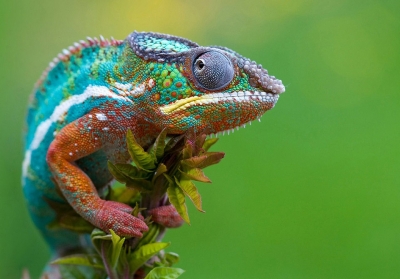
A chameleon is a very unique lizard that inhabits warm locations such as rainforests and deserts. They are known for their colour-changing abilities, long tongues, and unusual eye movements. The word chameleon comes from the Latin word chamaeleon, derived from Greek words chamai and leon, meaning ground and lion respectively. So, chameleon means lion on the ground. It is thought that the name refers to the ornate mane-shaped crests around the heads of some species.
The longest chameleon in the world is Parson’s chameleon (Calumma parsonii), which may grow up to 69.5 cm (about 27 inches) long. On the other hand, the world’s shortest chameleon, the male nano-chameleon (Brookesia nana), can be as small as 21.6 mm (about 0.9 inch) long. Most chameleons, however, are 17–25 cm (7–10 inches) long. The body is laterally compressed, the tail is sometimes curled, and the bulged eyes move independently of one another. Also, some chameleons possess helmet-shaped heads.
The chameleon’s specialized vision and a specialized tongue-projection system permit the capture of insects and even birds from a distance. The chameleon’s eyes are very good at detecting and regulating light. The lens of a chameleon’s eye is capable of focusing extremely rapidly, and it can enlarge visual images much like a telephoto lens. Although many other lizards also use the tongue to capture prey, most can expel it only a short distance.
Credit : Britannica
Picture Credit : Google



